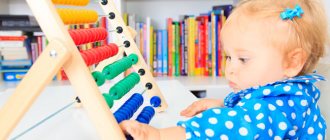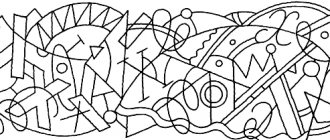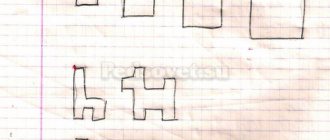The topic of our article is quite relevant since the motor skills of the fingers are closely interconnected with all mental processes, including speech. So A.V. Sukhomlinsky O. Indeed, well-developed fine motor skills have a beneficial effect on the development of all mental aspects. Fine motor skills are motor activities that are aimed at performing small movements with the hands and fingers and toes.
Scientists such as M.M. Koltsova, L.V. Antakova-Fomina, E.I. Isenin believe that the development of children’s speech directly depends on how the subtle movements of the fingers are formed.
To understand exactly how speech and movement are connected, let’s look at the three human brain centers that are responsible for speech. "Broca's area" or motor center produces speech; The speech organs take part in this. The “Wernicke's center” or auditory center is responsible for speech perception, the ability to recognize by ear. And thanks to the third “associative” centers, a person thinks through and analyzes the speech utterance. This is the process of human speech. With insufficient motor activity, the development of speech functions slows down.
Many researchers believe that the activity of the speech center in the central hemisphere of the brain is due to the leading role of the hand in human labor activity. F. Engels notes that the human brain develops under the influence of work and articulate speech.
The close relationship between hand movements and speech was traced in the studies of M.I. Zvonareva and T.P. Chrisman. The study found that when a child performs rhythmic movements with his fingers, the coordinated activity of the frontal and temporal regions of the brain sharply increases. This means that the speech areas of the brain are formed from impulses coming from the fingers.
When performing any movements, all analyzers take part (visual, auditory, tactile, and so on). In this case, the environment and its impact on the child play an important role. Starting from a very early age, it is necessary to pay attention to the development of both gross and fine motor skills. Finger movements occur from a very early age and are improved by the age of six. By this age, he independently performs various manipulations with objects.
T.B. Filicheva notes that imperfections in the development of fine motor skills of children with general speech underdevelopment affect the accuracy of movements, their speed and switchability. Such a child is not able to perform movements smoothly and quickly, or switch from one action to another. Children with general speech underdevelopment find it difficult to differentiate hand movements; they do not recognize some objects by touch (finger gnosis).
A neurological examination of children with general speech underdevelopment reveals the following features: awkward, undifferentiated movements; when overworked, synkenesis (friendly movements) are noted; make mistakes in spatial organization; movements are constrained, not synchronous; tremor (rapid movements of the fingers) is noted; control of one's own actions is impaired.
Thus, children with speech development disorders, later than children with normal speech development, begin to grab and hold objects, sit, walk, and jump on one and two legs. Underdevelopment of fine motor skills causes difficulties in lacing, fastening and unfastening buttons, and holding a spoon and fork in the correct position.
In children with general speech underdevelopment, along with poor coordination of movements, excessive motor activity is observed, which is characterized by sweeping, strong movements. Children with disorders of all aspects of speech have difficulties in the interaction of analyzers, that is, visual-motor and auditory-motor coordination is impaired. For example, when copying, a child with general speech underdevelopment makes many mistakes and distorts the drawing. Or when writing, the child writes letters incorrectly.
When studying auditory-motor coordination of movements, children with ODD make many mistakes. So, the child is given a sample of performing a task by ear - it is necessary to remember the rhythm of tapping in the absence of visual control and then reproduce it. In most cases, children either cope poorly with such a task or do not resort to performing it at all.
The hand movements of children with OHP are not coordinated; it may be difficult for them to perform movements with both hands at once. For example, when assembling a pyramid, a child cannot hold the base with one hand and string rings onto the rod with the other hand.
The so-called “fist, rib, palm” test by N.I. Ozeretskiy is difficult for children to complete. The meaning of the task is this: the child is alternately shown three different positions of his hands on the table, which change sequentially. This is a palm on the plane of the table, a fist, a palm with an edge on the surface. The child needs to complete this task together with the teacher, and then reproduce the same thing independently. As a rule, children with general speech underdevelopment perform this test more slowly than their peers whose speech development is normal. In addition, they get confused in the sequence when performing a task and perform it awkwardly.
Children with ODD find it most difficult to perform tasks in which the position of both hands changes simultaneously. They often make mistakes, make unnecessary movements or shorten them, and can reproduce the same movement without changing position.
Features of motor development are clearly visible in children's visual arts. Children with general speech underdevelopment are poorly oriented on a sheet of paper. They find it difficult to draw a straight line or draw small details, and this, in turn, later affects their writing. This is noticeable when a child writes a letter incorrectly or distorts it; "moves" off the line when writing sentences.
The development of fine motor skills is of great importance when teaching a child with ODD. At the same time, it is important to remember the development of all components that affect the child’s speech development. Thus, it is necessary to train coordination of movements, spatial coordination, motor memory, voluntary motor skills of the fingers; it is necessary to develop dynamic praxis, coordination of hand and eye movements.
Thus, fine motor skills play a big role in the development of a child’s speech. Its development is especially important when teaching a child with general speech underdevelopment, because speech movements are inextricably linked.
Levels of general speech underdevelopment
A distinctive feature of children with OPD is the late appearance of the first words (by 3-4, and sometimes by 5 years). Speech with OHP is characterized by incorrect sound and grammatical design, it is difficult to understand for others. The speech activity of such children is reduced.
Speech therapy classes for general speech underdevelopment in children are a necessity, since defective speech activity subsequently has a negative impact on memory and attention. OHP can lead a child to difficulties with mental operations, and also negatively affects cognitive activity. Children diagnosed with OHP are characterized by insufficient development of motor coordination, as well as problems with general, fine and speech motor skills. The development of OHP is often associated with:
- intrauterine hypoxia;
- Rhesus conflict;
- birth injuries;
- asphyxia;
- traumatic brain injuries;
- frequent infections;
- chronic diseases.
Inhibition of a child’s speech development can also be caused by factors such as an unfavorable speech environment, lack of attention and communication. Taking into account the degree of OHP, various levels of general speech underdevelopment are distinguished: 1, 2, 3 and 4.
Level 1 OHP is characterized by unformed phrasal speech. Children with this level of speech underdevelopment use “babble” words and one-word sentences in communication, supplementing them with facial expressions and gestures. The vocabulary of such children is very limited and includes, as a rule, individual sounds and onomatopoeia, sometimes a number of simple everyday words. Children with level 1 ODD have a disorder in phonemic hearing, as a result of which it is difficult for the child to understand and complete the task of phonemic analysis of a word.
If a child has level 2 OHP, then, along with babbling and gestures, he uses simple sentences (of 2-3 words) in his speech. It is worth noting that despite this, the statements of a child with this level of speech impairment are poor and uniform in content: as a rule, with the help of these sentences the child designates an object or action. Level 2 OHP is characterized by a significant lag in the child’s vocabulary level (according to his age category) - the child does not know the meaning of many words and replaces them in his speech with words of similar meaning. Phonemic processes are also disrupted: children with this speech disorder are not ready for sound analysis and synthesis.
Level 3 OSD is characterized by extensive phrasal speech, however, children with this speech pathology experience difficulties in constructing complex sentences, so their speech consists mainly of simple speech structures. The vocabulary of children with level 3 OHP is quite extensive: such children use almost everything when communicating parts of speech, however, often use inaccurate names for objects. Phonemic perception is impaired to a lesser extent than in OHP levels 1 and 2.
Level 4 OHP is characterized by difficult sound pronunciation and repetition of complex words. Children with this level of speech underdevelopment tend to make mistakes in word formation and inflection, which is due to a low level of phonemic perception. The vocabulary of such children is quite wide, but it is worth noting that it is difficult for a child with such a speech pathology to understand the meaning of rarely used words. Such children experience particular difficulties when it comes to the need for a logical presentation of events: they often miss the main thing and focus on secondary details. Also, the narration is characterized by repetition of what has been said before.
Overcoming general speech underdevelopment
The first children's medical center - treatment of OCD of any level. Currently, the Center’s specialists have accumulated sufficient experience to successfully correct various speech pathologies.
Correction of OHP by a speech therapist is structured differentially, taking into account the level of speech development. Classes for general speech underdevelopment are aimed at:
- development of speech activity;
- understanding speech;
- work on the formation of the correct phonetic design of the statement;
- development of coherent speech;
- strengthening correct sound pronunciation;
- development of grapho-motor skills.
The list of speech therapy services at the First Children's Medical Center includes:
- consultation with a speech therapist;
- speech therapy massage;
- individual speech therapy sessions.
You can find out the cost of services in the “Price List” section.
Prevention of OHP
Corrective work to overcome ODD is a very long and labor-intensive process that should begin as early as possible (from three to four years of age).
Prevention of general speech underdevelopment in children is similar to the prevention of those clinical syndromes in which it occurs (alalia, dyslalia, bradyllalia, dysarthria, etc.). It is worth noting that parents should pay due attention to the speech environment in which the child is raised. In addition, you need to monitor the development of the baby’s speech activity and, if any problems arise, seek the advice of a specialist as soon as possible.
By contacting our Center, you will receive qualified help from a speech therapist who will pay special attention to your child and give answers to all your questions. We are happy to help you! First Children's Medical Center: Children's health - parents' peace of mind!
Share on social networks:
To make an appointment with a doctor
Choose a doctor
www.Logopedy.ru
Dektyareva Svetlana Anatolyevna, teacher-speech therapist, Mariinsk Original : Certificate : not issued
Introduction
Scientists have proven that the development of the hand is closely related to the development of speech and thinking of the child. The level of development of fine motor skills is one of the indicators of intellectual readiness for school learning. Typically, a child who has a high level of development of fine motor skills can reason logically, has sufficiently developed memory and attention, and coherent speech. Teachers note that first-graders often experience serious difficulties in mastering writing skills. Writing is a complex skill that involves making fine, coordinated movements of the hand. In preschool age, it is preparation for writing that is important, and not teaching it, which often leads to the formation of incorrect writing techniques. The ability to perform small movements with objects develops in older preschool age; it is by the age of 5-6 that the maturation of the corresponding areas of the brain and the development of small muscles of the hand generally end.
As a result of targeted and systematic training in these classes, the child will learn to navigate on a sheet of paper, fold it, which will develop the coordination of his hands and provide him with eye control over the movement of his hand with a particular instrument. He will be fluent in line drawing techniques, which will help him avoid problems with handwriting and other writing skills in the future. His ability to analyze and synthesize impressions from the world around him will develop, and a conscious approach to the selection of topics, plots, and graphic techniques will be developed. Concepts about plane, relief, volume, space and time will be formed, which will allow him to study in the future without unnecessary strain on mental and physical strength.
Development of manual skills
You need to start working on developing fine motor skills from a very early age. Already an infant can massage his fingers (finger gymnastics), thereby influencing the active points associated with the cerebral cortex. In early and early preschool age, you need to perform simple exercises, accompanied by a poetic text, and do not forget about developing basic self-care skills: fastening and unfastening buttons, tying shoelaces, etc.
And, of course, in older preschool age, work on developing fine motor skills and coordination of hand movements should become an important part of preparation for school, in particular for writing.
Why is it so important for children to develop fine motor skills? The fact is that in the human brain the centers responsible for speech and finger movements are located very close. By stimulating fine motor skills and thereby activating the corresponding parts of the brain, we also activate neighboring areas responsible for speech.
A consequence of poor development of general motor skills, and in particular the hands, is the general unpreparedness of most modern children for writing or problems with speech development. With a high degree of probability we can conclude that if everything is not in order with speech, it is probably problems with motor skills.
However, even if the child’s speech is normal, this does not mean that the child is good at using his hands. If at the age of 4-5 years tying shoelaces causes difficulties for a child, and nothing can be molded from plasticine except balls and sausages, if at 6 years old sewing on a real button is an impossible and dangerous task, then your child is no exception.
Unfortunately, most parents learn about problems with coordination of movements and fine motor skills only before school. This results in an increased burden on the child: in addition to learning new information, he also has to learn to hold a pencil in his unruly fingers.
More than anything else, a small child wants to move; for him, movement is a way of understanding the world. This means that the more accurate and clear the children’s movements, the deeper and more meaningful the child’s acquaintance with the world.
Children with ODD show deviations in the emotional-volitional sphere: decreased motivation, instability of interests, decreased observation, difficulties in communicating with others, lack of self-confidence and, as a result, negativism, aggressiveness, touchiness, irritability.
The development of a child’s motor sphere must begin from the first days of being in a speech therapy group. Work is being carried out in several directions at once:
1 – Development of self-service skills. The child needs to be constantly trained in fastening buttons, zippers, tying bows, laces on shoes, knots on a scarf, putting his clothes in a locker, etc.
2 – Conducting special speech therapy sessions to develop articulation skills.
3 – Conducting special exercises, activities and didactic games aimed at developing fine motor skills.
Special exercises include: massage and self-massage of the hands with special balls, self-massage of the palms and fingers with natural material (cones, chestnuts, acorns, nuts, etc.), self-massage with pencils, finger gymnastics, launching tops, attaching clothespins, stringing beads, weaving, knitting , tracings on stencils and patterns.
Activities include drawing, modeling, appliqué, design, and various types of manual labor.
Didactic games include mosaics, folding cubes, cut-out pictures, puzzles, and puzzles.
4 – Conducting physical education and music classes, outdoor games and dynamic breaks, as a result of which children develop balance, dexterity, coordination of movements, the ability to voluntarily change body position, and sensorimotor functions.
Corrective work includes a series of preparatory exercises that ensure the formation of hand-eye coordination, as well as the development of fine motor skills of the fingers. At the same time, the child develops the ability to accurately and deftly perform certain movements.
Main goals:
1. Teach children to walk in a certain direction (in a straight line, in a circle) to a given rhythm.
2. Teach children to stand alternately on their right (left) leg.
3. Teach children to catch the ball after hitting the floor several times.
4. Teach children to roll (throw) the ball from one hand to the other.
5. Using ribbons and strings. Teach children to tie and untie a knot or bow.
6. Teach children to alternately bend and straighten the fingers of their right and left hands, and make a lattice of fingers.
7. Teach children to alternately connect the thumb and index finger, middle, ring, and little fingers.
8. Teach children to rhythmically perform the “palm-fist-palm” movements.
The development of gross and fine motor skills is facilitated by the child completing a set of tasks, games, and exercises that can be done at home together with parents.
Working with balls. Several balls are placed on the table in front of the child. A box is placed at some distance from them. An adult shows and explains how to roll the ball so that it hits the box. First, the adult helps the child in completing this task, then gradually limits the help and ensures that the child completes the task independently.
You can put an empty milk bottle on the table, put several balls on both sides of it. The adult takes the ball that is on the right side of the child and throws it into the bottle, and then invites the child to do the same. Completing this task will help determine how much control the child has with one and the other hand, how he grasps the ball (equally with the right and left or not), whether he puts all the balls in, whether he scatters a lot, whether there is a pronounced awkwardness of movements.
Working with bricks.
a) “Path” - laying out several bricks in a row.
b) “Fence” - laying out several bricks on an edge.
c) “Bench” - builds from two cubes and a transverse bar on top.
d) “Table” - made in the same way as a bench; the cross bar is applied to one cube.
e) “Gate” - bricks are placed perpendicular to the plank.
Using building material, you can also propose to build a high chair, crib, sofa, etc.
Working with button objects. A desk bell is placed on the table in front of the child. The adult shows the child that the bell button can be pressed with any finger and asks the child to press one by one with all fingers.
Working with a spray gun. It is easy to press the spray bulb with three fingers and direct the resulting stream of air onto the cotton wool so that it moves smoothly across the table.
Working with beads. An adult places beads of different sizes but the same color (or the same size but different colors, or different sizes and different colors) on the table. It is suggested to make beads yourself, in which large and small beads alternate, or red and blue, etc. When performing this task, it is important that the child not only correctly threads the thread into the holes of the beads, but also follows a certain sequence of stringing the beads. For this purpose, you can use caps from different bottles, having previously made holes in them, and fishing line.
Working with shells. Lay out on the table various patterns of shells, pebbles, buttons, fruit seeds, peas, beans and other small items.
Working with clothespins. Draw and cut out a circle from cardboard, color it so that it looks like a sun without rays. Show the child and ask what it looks like? Suggest making rays using clothespins. You can do the same with other pictures, for example, invite the child to make legs for an insect, petals for a flower, leaves for a tree, etc.
Game "Magic Pencil".
Goal: development of attention, auditory-motor coordination, formation of motor activity and flexibility of fingers and hands.
Equipment: a simple unsharpened pencil with a faceted surface.
The adult gives the child a pencil and says:
— Hold the pencil between your palms and roll it. Listen to how he makes noise. Warm up your palms. Make noise with a pencil near your right ear. And now I will listen to the noise of your pencil.
— Place your elbows on the table. Take the pencil by the ends with your thumb, index, and ring fingers of your right and left hands, twist it back and forth.
—Put your left hand on the table. Roll the pencil first along the outside of your left and then your right hand.
— Place your elbows on the table, hold two pencils between your fingers: one pencil is held with the index fingers, and the other with the middle fingers of both hands. Connect your index and middle fingers, imitating the movement of scissors.
Used Books
1. V.I. Import Organization of educational and health work in preschool educational institutions / V.I. Import, I.T. Konovalova. - M.: Sfera, 2006.
2. Zhukova N.S., Filicheva T.B. Speech therapy. Overcoming general speech underdevelopment in preschool children. - Ekaterinburg ARD LTD, 1999.
Social commentary Cackle






